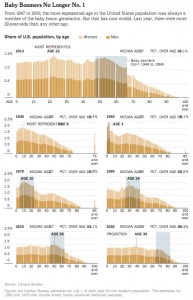Here are some examples of frequency histograms showing the age distributions of the US population at different times in history (and projected into the future):
- From the New York Times: “The Aging of America” (Published: February 5, 2011)
- A similar post appeared on WashingtonPost’s Wonkblog: (published: August 13, 2013), which included this: “This is a mesmerizing little animation created by Bill McBride of Calculated Risk. It shows the distribution of the U.S. population by age over time, starting at 1900 and ending with Census Bureau forecasts between now and 2060.”

What do you notice about how the distributions evolve over time? Click thru to either the CalculatedRisk blog post on which this animation first appeared or to the WashingtonPost link to read some discussion.
Also here is a related set of histograms that were featured in the NYT Business section in May 2014, as part of an article titled “Younger Turn for a Graying Nation“:
That was an installment of a weekly column in the NYT Business section titled “Off the Charts,” which discussed a graph and the underlying data.




